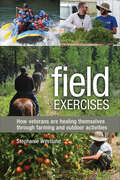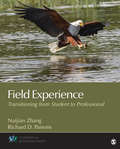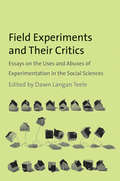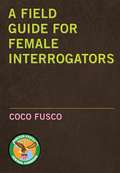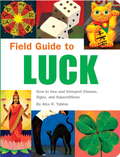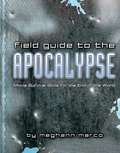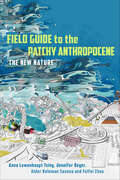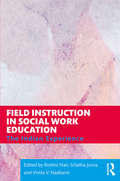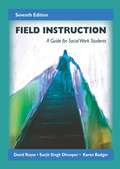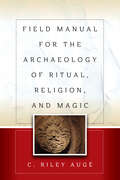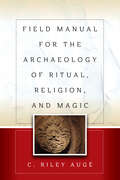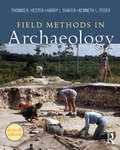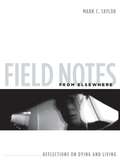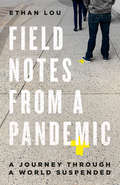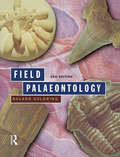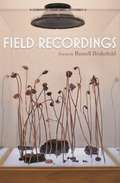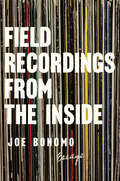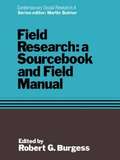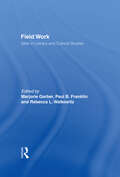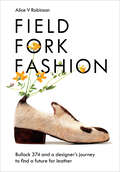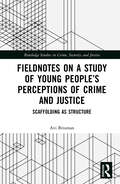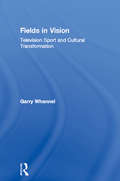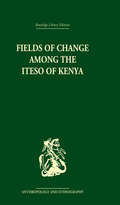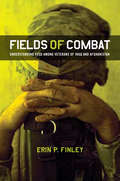- Table View
- List View
Field Exercises: How Veterans Are Healing Themselves through Farming and Outdoor Activities
by Stephanie WestlundHow connecting with nature is helping veterans reintegrate into civilian life and recover from PTSD.There are nearly twenty-five million veterans and active-duty soldiers in North America. Some experts estimate that more than one quarter of these men and women suffer from post-traumatic distress, and many other military persons experience difficulty reintegrating into civilian life. While conventionally prescribed treatments primarily involve medication and therapy, many people are discovering additional ways to manage their injuries and reduce their suffering.Field Exercises: How Veterans Are Healing Themselves through Farming and Outdoor Activities shares the compelling stories of men and women who are finding relief from stressful and traumatic military experiences, while also establishing community networks and other peer support initiatives. Stephanie Westlund examines:The deep and far-reaching connections between nature and human healthThe tremendous impact of stress and trauma on survivors' livesResources and groups providing opportunities in the emerging field of “Green Care”.Field Exercises offers hope for veterans searching for methods to ease the transition to civilian life and recover from military stress and trauma. This book will appeal to millions of North American soldiers, veterans, and their loved ones, doctors, psychiatrists, social workers and other caregivers, other groups struggling with high rates of stress and post-traumatic experience, and all those interested in the relationship between nature and human health.Stephanie Westlund holds a PhD in peace and conflict studies. She has been conducting research with veterans since 2009, and continues to be inspired by their courage and personal resolve to move through pain toward recovery, and their unrelenting desire to serve their communities.
Field Experience: Transitioning From Student to Professional (Counseling and Professional Identity)
by Dr Richard D. Parsons Dr Naijian ZhangA blueprint for doing clinical work in field experience, Field Experience: Transitioning from Student to Professional aids students in developing their professional identity on their journey toward becoming a counselor. Authors Naijian Zhang and Richard D. Parsons help students integrate the knowledge they learn across the curriculum by presenting a roadmap of how to start, navigate, and finish a practicum or internship. Throughout the book, coverage of CACREP standards, case illustrations, exercises, and real-life examples create an accessible overview of the entire transitioning process. Field Experience is part of the SAGE Counseling and Professional Identity Series, which targets specific competencies identified by CACREP (Council for Accreditation of Counseling and Related Programs).
Field Experience: Transitioning From Student to Professional (Counseling and Professional Identity)
by Dr Richard D. Parsons Dr Naijian ZhangA blueprint for doing clinical work in field experience, Field Experience: Transitioning from Student to Professional aids students in developing their professional identity on their journey toward becoming a counselor. Authors Naijian Zhang and Richard D. Parsons help students integrate the knowledge they learn across the curriculum by presenting a roadmap of how to start, navigate, and finish a practicum or internship. Throughout the book, coverage of CACREP standards, case illustrations, exercises, and real-life examples create an accessible overview of the entire transitioning process. Field Experience is part of the SAGE Counseling and Professional Identity Series, which targets specific competencies identified by CACREP (Council for Accreditation of Counseling and Related Programs).
Field Experiments and Their Critics
by Dawn Langan TeeleIn recent years, social scientists have engaged in a deep debate over the methods appropriate to their research. Their long reliance on passive observational collection of information has been challenged by proponents of experimental methods designed to precisely infer causal effects through active intervention in the social world. Some scholars claim that field experiments represent a new gold standard and the best way forward, while others insist that these methods carry inherent inconsistencies, limitations, or ethical dilemmas that observational approaches do not. This unique collection of essays by the most influential figures on every side of this debate reveals its most important stakes and will provide useful guidance to students and scholars in many disciplines.
Field Guide for Female Interrogators, A
by Coco FuscoThe world was shocked by the images that emerged from Abu Ghraib, the US-controlled prison in Iraq. Lynndie England, the young female army officer shown smiling devilishly as she humiliated male prisoners, became first a scapegoat and then a victim who was "just following orders." Ignored were the more elemental questions of how women are functioning within conservative power structures of government and the military. Why do the military and the CIA use female sexuality as an interrogation tactic, and why is this tactic downplayed and even ignored in internal investigations of prisoner abuse?Combining an art project with critical commentary, Coco Fusco imaginatively addresses the role of women in the war on terror and explores how female sexuality is being used as a weapon against suspected Islamic terrorists. Using details drawn from actual accounts of detainee treatment in US military prisons, Fusco conceives a field guide of instructional drawings that prompts urgent questions regarding the moral dilemma of torture in general and the use of female sexuality specifically. Fusco assesses what these matters suggest about how the military and the state use sex, sexuality, and originally feminist notions of sexual freedom.
Field Guide to Luck
by Alys R. YablonTake Control of Your Destiny! From the good luck provided by shamrocks, rabbits's feet, and horseshoes to the misfortune caused by broken mirrors, black cats, and umbrellas opened indoors, our lives are filled with signs and superstitions that guide our destiny and influence our fate. Fortunately, Field Guide to Luck can help you recognize dozens of influential charms, dates, sayings, and symbols wherever you encounter them. Learn what objects are on your side, which practices are best avoided, and where these curious beliefs come from. This indispensable guide reveals their fascinating origins and offers tips for putting them into practice. With Lady Luck on your side and a lucky penny in your pocket, you're sure to lead a charmed life!
Field Guide to the Apocalypse: Movie Survival Skills for the End of the World
by Meg Marcothe end is near Surviving the apocalypse is one thing. Enjoying life after most of civilization is wiped out -- that's entirely different. Maybe you can outrun an avalanche, or escape a burning building, but can you really cut it after the unthinkable happens? Can you, for example, deal with damn dirty apes, convert your car to run on bathtub gin, or synthesize a species-saving vaccine from your own mucus? No? Obviously, it's not going to be as easy as you thought to come out of Armageddon as the new ruling king of the world. Any chump off the street could be lucky enough to have the immunity to survive the all-of-humanity-killing disease, or be the one dude who happens to make it through a meteor strike. But not everyone will know what clothes to wear to intimidate, or what kind of vehicle you want to be driving in the postapocalyptic wasteland. Not everyone will have the sense to discern whether their food is, in fact, people. You can survive the apocalypse without this book. But the apocalypse isn't the problem: It's what happens afterward. You against the other people left in the world. You'd better be prepared.
Field Guide to the Patchy Anthropocene: The New Nature
by Anna Lowenhaupt Tsing Feifei Zhou Jennifer Deger Alder Keleman SaxenaNature has gone feral. How can we re-attune ourselves to the new nature? A field guide can help. While the global scientific community recently made headlines by ruling the Anthropocene—an era many date to the Industrial Revolution when human action truly began to transform the planet—did not qualify for a geological epoch quite yet, understanding the nature of human transformation of the Earth is more important than ever. The effects of human activity are global in scope, but take shape within distinct social and ecological "patches," discontinuous regions within which the key actors may not be human, but the plants, animals, fungi, viruses, plastics, and chemicals creating our new world. Field Guide to the Patchy Anthropocene takes stock of our current planetary crisis, leading readers through a series of sites, thought experiments, and genre-stretching descriptive practices to nurture a revitalized natural history. Field guides teach us how to notice, name, and so better appreciate more-than-human worlds. They hone our powers of observation and teach us to see the world anew. Field-based observations and place-based knowledge cultivation—getting up-close and personal with patchy dynamics—are vital to truly grapple with the ecological challenges and the historical conjunctures that are bringing us to multiple catastrophic tipping points. How has commercial agriculture runoff given rise to comb jellies in the Black Sea? What role did the Atlantic slave trade play in the worldwide spread of virus-carrying mosquitoes? How did the green revolution transform the brown planthopper into a superpredator in Philippine rice fields? Questions like these open up new ways of understanding, and ways of living through, the epoch that human activity has ushered in. This Field Guide shifts attention away from knowledge extractive practices of globalization to encourage skilled observers of many stripes to pursue their commitments to place, social justice, and multispecies community. It is through attention to the beings, places, ecologies, and histories of the Anthropocene that we can reignite curiosity, wonder, and care for our damaged planet.
Field Instruction in Social Work Education: A Guide to Research in India
by Roshni Nair Srilatha Juvva Vimla V. NadkarniA comprehensive guide to social work praxis, this book provides a clear conceptual understanding of fieldwork supervision in India. It elaborates on the dynamic components of fieldwork instruction – the methodologies and effective strategies, the supervisor–student–agency triad, challenges and the future. The volume underlines the importance of student mentoring and the imperative need to develop creative and competent strategies to make fieldwork education more responsive and effective. It also emphasises the need for the inclusion of social justice-oriented perspectives and approaches in fieldwork training in India. Instructive and anecdotal, the chapters in this volume reflect on the challenges which students and supervisors face on a regular basis in different environments while dealing with critical circumstances. The focus of the book is to delineate strategies and approaches which promote skill building and the ability in students to understand sociocultural contexts of the field and engage with them effectively. This volume will be an essential resource for social work educators, field practitioners and students of social work, law, public policy, sociology and social entrepreneurship.
Field Instruction: A Guide for Social Work Students
by David Royse; Surjit Singh Dhooper; Karen BadgerThe authors integrate classroom knowledge and real-world settings by providing case examples, critical thinking questions, and exercises throughout the text. Each chapter's coverage is linked to CWSE's 2015 Competencies and Behaviors.
Field Manual for the Archaeology of Ritual, Religion, and Magic
by C. Riley AugéBy bringing together in one place specific objects, materials, and features indicating ritual, religious, or magical belief used by people around the world and through time, this tool will assist archaeologists in identifying evidence of belief-related behaviors and broadening their understanding of how those behaviors may also be seen through less obvious evidential lines. Instruction and templates for recording, typologizing, classifying, and analyzing ritual or magico-religious material culture are also provided to guide researchers in the survey, collection, and cataloging processes. The bulleted formatting and topical range make this a highly accessible work, while providing an incredible wealth of information in a single volume.
Field Manual for the Archaeology of Ritual, Religion, and Magic
by C. Riley AugéBy bringing together in one place specific objects, materials, and features indicating ritual, religious, or magical belief used by people around the world and through time, this tool will assist archaeologists in identifying evidence of belief-related behaviors and broadening their understanding of how those behaviors may also be seen through less obvious evidential lines. Instruction and templates for recording, typologizing, classifying, and analyzing ritual or magico-religious material culture are also provided to guide researchers in the survey, collection, and cataloging processes. The bulleted formatting and topical range make this a highly accessible work, while providing an incredible wealth of information in a single volume.
Field Methods in Archaeology: Seventh Edition
by Thomas R Hester Harry J Shafer Kenneth L FederField Methods in Archaeology has been the leading source for instructors and students in archaeology courses and field schools for 60 years since it was first authored in 1949 by the legendary Robert Heizer. Left Coast has arranged to put the most recent Seventh Edition back into print after a brief hiatus, making this classic textbook again available to the next generation of archaeology students. This comprehensive guide provides an authoritative overview of the variety of methods used in field archaeology, from research design, to survey and excavation strategies, to conservation of artifacts and record-keeping. Authored by three leading archaeologists, with specialized contributions by several other experts, this volume deals with current issues such as cultural resource management, relations with indigenous peoples, and database management as well as standard methods of archaeological data collection and analysis.
Field Notes from Elsewhere: Reflections on Dying and Living
by Mark C. TaylorIn the fall of 2005, Mark C. Taylor, the controversial public intellectual and widely respected scholar, suddenly fell critically ill. For two days a team of forty doctors, many of whom thought he would not live, fought to save him. Taylor would eventually recover, but only to face a new threat: surgery for cancer. "These experiences have changed me in ways I am still struggling to understand," Taylor writes in this absorbing memoir. "After the past year, I am persuaded that I have done enough fieldwork to write a book that combines philosophical and theological reflection with autobiographical narrative. Writing is not only possible but actually seems necessary."Field Notes from Elsewhere is Taylor's unforgettable, inverted journey from death to life. Each of his memoir's fifty-two chapters and accompanying photographs recounts a morning-to-evening experience with sickness and convalescence, mingling humor and hope with a deep exploration of human frailty and, conversely, resilience. When we confront the end of life, Taylor explains, the axis of the lived world shifts, and everything must be reevaluated. As Taylor sorts through his remembrances, much that once seemed familiar becomes strange, paradoxical, and contradictory. He reads his experience with and against ghosts from his past, recasting the meaning of mortality, sacrifice, solitude, and abandonment, along with a host of other issues, in light of modern ways of dying. "You never come back from elsewhere," Taylor concludes, "because elsewhere always comes back with you."
Field Notes from a Pandemic: A Journey Through a World Suspended
by Ethan LouEqual parts travelogue and pandemic guide, journalist Ethan Lou examines the societal effects of COVID-19 and takes us on a mesmerizing journey around a world that will never be the same.Visiting Beijing in January to see his dying grandfather, Canadian journalist Ethan Lou unknowingly walks into a state under siege. In his journey out of China and into other hot zones in Asia and Europe, he finds himself witnessing the very earliest stages of a virus that will forever change the world as we know it. Lou argues that Coronavirus will have a far greater impact than SARS, for example, simply because China is now many more times integrated with the increasingly interconnected world. Over decades, globalization has crafted a world painfully sensitive and susceptible to shocks such as this pandemic. A crisis like it has thus been long overdue--and we have yet to see it unfold fully. In our integrated world, events that may previously be isolated now ripple farther and wider and in ways we do not expect and cannot foresee. We have not seen the worst, and if and when we outlast this pandemic, nothing will ever be the same--not just healthcare systems but also economies, politics and culture. Decisions now--or indecisions--will shape and define the world for decades.These ideas are fleshed out through the virus's spawning and how it spread, the unprecedented measures to contain it and an examination of past pandemics and other crises and how they shaped the world--and an argument for why this one's different. Lou shows how drastically the virus has transformed the world and charts the greater and more radical shifts to come. His ideas and arguments are framed around his journey around the world, whose path the virus seemed to follow until he landed safely in quarantine in a small town in Germany where he was able to take stock and start telling his story.
Field Palaeontology
by Roland Goldring"This is the major text on the integration of field palaeontology and sedimentology, particularly valuable for both practical lab exercises and students working independently and unsupervised on field projects"Reviewer's commentField Palaeontology provides a comprehensive, rigorous and unique approach to the analysis of fossils and sediments and offers a practical field guide which no palaeontology student can afford to be without.The past decade has seen immense changes in palaeontology and in the study of sedimentary rocks in general. This edition has been thoroughly revised to take into account these advancements in the subject to produce a book that is unique in its coverage of palaeontology and sedimentology. It aims to provide a basis for evaluating the information potential of fossiliferous sediments, and then to give an outline of the strategy and tactics whicn can be adopted in the field.Field Palaeontology is written for advanced undergraduate courses in palaeontology, palaeoecology, palaeobiology, sedimentology and biostratigraphy within geoscience and geology degrees. It is also useful reading for Masters earth science students and first year postgraduates looking for a grounding in the basics of the subject.
Field Recordings (Made in Michigan Writers Series)
by Russell BrakefieldFirmly rooted in the dramatic landscapes and histories of Michigan, Field Recordings uses American folk music as a lens to investigate themes of personal origin, family, art, and masculinity. The speakers of these poems navigate Michigan’s folklore and folkways while exploring more personal connections to those landscapes and examining the timeless questions that occupy those songs and stories. With rich musicality and lyric precision, the poems in Field Recordings look squarely at what it means to be a son, a brother, an artist, a person. Inspired by the life and writings of famous ethnomusicologist Alan Lomax, Field Recordings is divided into three sections. It is anchored by a long poem that tracks Alan Lomax on his 1938 journey through Michigan collecting music for the Library of Congress. This poem speaks to the complex process of recording the voices and stories of working-class musicians in Michigan in the early part of the twentieth century. It is rich with the pleasures of music and storytelling and is steeped in history. Like the rest of the collection, it also speaks to the questions and anxieties that, like music, transcend time and technology. In poems alternately elegiac and rhapsodic, Field Recordings explores the way art is produced and translated, the line between innovation and appropriation, and the complex, beautiful stories that are passed between us. From poetry readers to poets, music fans to musicians, this collection will undoubtedly appeal to a wide audience.
Field Recordings from the Inside: Essays
by Joe BonomoUsing as its epigraph and unifying principle Luc Sante’s notion that "Every human being is an archeological site,” Field Recordings from the Inside provides a deep and personal examination at the impact of music on our lives. Bonomo effortlessly moves between the personal and the critical, investigating the ways in which music defines our personalities, tells histories, and offers mysterious, often unbidden access into the human condition. The book explores the vagaries and richness of music and music-making-from rock and roll, punk, and R&B to Frank Sinatra, Nashville country, and Delta blues-as well as the work of a diverse group of artists and figures-Charles Lamb, music writer Lester Bangs, painter and television personality Bob Ross, child country musician Troy Hess, and songwriter Greg Cartwright.Mining the often complex natures and shapes of the creative process, Field Recordings from the Inside is a singular work that blends music appreciation, criticism, and pop culture from one of the most critically acclaimed music writers of our time.
Field Research: A Sourcebook And Field Manual
by Robert BurgessField Research first published in 1982
Field Work: Sites in Literary and Cultural Studies (CultureWork: A Book Series from the Center for Literacy and Cultural Studies at Harvard)
by Marjorie Garber Rebecca L. Walkowitz Paul B. FranklinFirst published in 1996. Routledge is an imprint of Taylor & Francis, an informa company.
Field, Fork, Fashion: Bullock 374 and a Designer’s Journey to Find a Future for Leather
by Alice V Robinson*From one of the Vogue Business 100 Innovators List - 2023 "[T]his wonderful project and book, executed with great charm and creativity, is an important message." Anya Hindmarch In this personal investigation into ethical and traceable leather, fashion designer Alice Robinson begins a ground-breaking journey into the origin story of leather and its connection to food and farming. As a fashion student, Alice started to question the material she worked with. Leather is universally acknowledged as a luxury material, from which desirable bags, shoes and clothing are made. But how much do we know about where it comes from? Alice’s questions led back to her childhood home in rural Shropshire, where she decided to buy Bullock 374 and follow its journey from a local farm to the abattoir, then to the butchery and finally to the tannery. The journey culminates with Alice’s own design practice as she creates a collection based on this single hide. In doing so, Alice would begin to see the bigger picture – and connect farm, food and fashion for the first time to understand the true meaning of provenance, value and beauty.
Fieldnotes on a Study of Young People’s Perceptions of Crime and Justice: Scaffolding as Structure (Routledge Studies in Crime, Security and Justice)
by Avi BrismanThis book is an ethnographic examination of the young people who serve voluntarily as judges, advocates and other court personnel at the Red Hook Youth Court (RHYC) in Brooklyn, New York—a juvenile diversion program designed to prevent the formal processing of juvenile offenders—usually first-time offenders—for low-level offenses (such as fare evasion, truancy, vandalism) within the juvenile justice system. Focusing on the nine-to-ten-week long unpaid training program that the young people undergo prior to becoming RHYC members, this book offers a detailed description of young people’s experiences learning about crime, delinquency, justice, and law. Combining moments of self-reflection and autobiographical elements into largely "uncooked" fieldnotes, the book seeks to demonstrate the hegemonic operations of a court (the Red Hook Community Justice Center (RHCJC)—a multi-jurisdictional problem-solving court and community center where the RHYC is housed), the processes in which it secures belief in formal justice and the rule of law, ensures consent to be governed, and reproduces existing social structures. An accessible and compelling read, this book will appeal to students and scholars of criminology, law, sociology, and youth justice, as well as to those undertaking ethnographic research on young people, crime and justice.
Fields in Vision: Television Sport and Cultural Transformation (Communication and Society)
by Garry WhannelFields in Vision offers a comprehensive and analytical study of the international phenomenon of television sports coverage. Garry Whannel considers the historical development of sport on television, the growth of sponsorship and the way that television and sponsorship have re-shaped sport in the context of the enterprise culture. Drawing on archival research, Whannel first charts the development of the BBC Outside Broadcast department, and the growing battle for dominance between BBC and ITV, showing how sponsorship and the rising power of sports agents began to transform sport - not only in the UK but across the world - in the 1960s. He goes on to examine the implications of this vast and escalating global network during the 1980s by analysing the central role that stars and narratives began to play in television sport, presenting case studies of major contests such as Coe versus Ovett and Decker versus Budd. His study also takes into account one of the more indirect, but no less significant results of international televised sport - the rise of popular fitness chic and the American monopoly of the workout boom of the 1980s. Fields in Vision explains the development of television sport by linking its economic transformation with the cultural forms through which it is represented, offering a study encompassing not simply the sports world, but our relationship with television and the media industries as a whole.
Fields of Change among the Iteso of Kenya
by Ivan KarpFields of Change is a study of the means by which the Iteso adapted to the imposition of colonial rule and the loss of political independence. It explores their pacification and incorporation into a colonial state and the effects that these processes have had on Iteso territorial and political systems. At the same time it examines the way in which the political system both affected and was affected by other aspects of the Iteso social system, most notably in the fields of religion, descent and domestic kinship. First published in 1978.
Fields of Combat: Understanding PTSD among Veterans of Iraq and Afghanistan (The Culture and Politics of Health Care Work)
by Erin P. Finley"If you consider Iraq—like I do, probably twenty-nine out of thirty days—to be the pinnacle of your life, then where do you go from there? And I'm sure that a lot of veterans feel that way. To them, that was it. That was everything. So now what? They have to find something meaningful and purposeful.""When I got back from Afghanistan, there was not even so much as a briefing that said, 'Let us know if you're having problems.' There wasn't so much as a phone number. There was literally nothing.""I knew it was crazy. I was thinking, the guy on the roof's either a sniper or he's going to radio ahead. And then I thought, this is San Antonio. There's not snipers on the roof, nobody's going to blow me up here.""Whenever I look at people back here at home, I know what they're going to look like dead. I know what they look like with their brains blown out or jaws blown off or eyes pulled out. When I look at somebody I see that, to this day."—Voices of veterans interviewed in Fields of CombatFor many of the 1.6 million U.S. service members who have served in Iraq and Afghanistan since 2001, the trip home is only the beginning of a longer journey. Many undergo an awkward period of readjustment to civilian life after long deployments. Some veterans may find themselves drinking too much, unable to sleep or waking from unspeakable dreams, lashing out at friends and loved ones. Over time, some will struggle so profoundly that they eventually are diagnosed with post-traumatic stress Disorder (PTSD).Both heartbreaking and hopeful, Fields of Combat tells the story of how American veterans and their families navigate the return home. Following a group of veterans and their personal stories of war, trauma, and recovery, Erin P. Finley illustrates the devastating impact PTSD can have on veterans and their families. Finley sensitively explores issues of substance abuse, failed relationships, domestic violence, and even suicide and also challenges popular ideas of PTSD as incurable and permanently debilitating. Drawing on rich, often searing ethnographic material, Finley examines the cultural, political, and historical influences that shape individual experiences of PTSD and how its sufferers are perceived by the military, medical personnel, and society at large. Despite widespread media coverage and public controversy over the military's response to wounded and traumatized service members, debate continues over how best to provide treatment and compensation for service-related disabilities. Meanwhile, new and highly effective treatments are revolutionizing how the Department of Veterans Affairs (VA) provides trauma care, redefining the way PTSD itself is understood in the process. Carefully and compassionately untangling each of these conflicts, Fields of Combat reveals the very real implications they have for veterans living with PTSD and offers recommendations to improve how we care for this vulnerable but resilient population.
